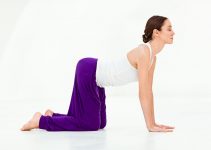
| Sanskrit Pronunciation | Parsvottanasana (parsh-voh-tahn-AHS-anah) |
| Meaning | parsa = side / uttana = intense / asana = pose |
| Pose Type | Standing and forward bend |
| Pose Level | Intermediate |
| Anatomy | Back muscles, hips, hamstrings |
| Other Names | Pyramid pose, Intense side stretch pose, side flank intense stretch, single-leg forward bend. |
Parsvottanasana, also known as Pyramid Pose, is an excellent posture for enhancing confidence, body awareness, and improving posture. This intermediate-level standing pose incorporates forward bending, inversion, and full-body stretching. Pyramid Pose engages the back muscles, arms, and effectively warms up the legs.
To enter the pose, start by aligning both heels sideways, separating the legs, and bringing the hands together in reverse prayer position. Then, gradually bend the torso forward until the head touches the shin of the front leg
Parsvottanasana Meaning
The name of parsvottanasana is derived from Sanskrit. It includes four terms that better clarify its meaning and significance.
- ‘Parsva‘ means ‘side‘
- ‘Ut‘ refers to ‘intense‘
- ‘Tan‘ means ‘to stretch‘
- ‘Asana‘ is ‘pose‘.
This is the crux of what the practitioner has to do for performing this pose, i.e. bending the body to one side and stretching immensely.
Parsvottanasana is better understood as a stage between Parivrtta Trikonasana and Utthita Trikonasana. Bending the body forward and balancing in this inversion gives the body a pyramid shape, hence the name.
Parsvottanasana Practice Guide

Before you do this pose, go through the following points for safe & easy practice:
Contraindications
- Back injury – Avoid attempting the pose with full forward bend with a back injury.
- High blood pressure – In case of a high bold pressure consulting a doctor beforehand would be a safer move.
- Neck stiffness – Do not go deeper in this asana if you are experiencing stiffness in the neck.
- Injured hamstrings, hips, or legs – Never perform this pose with any injury as the stretch involved is too intense for the muscles.
- Pregnancy – Avoid performing parsvottanasana during pregnancy, especially during later months.
Preparatory poses
- Tree pose (Vrikshasna)
- Cow Face Pose (Gomukhasana)
- Standing forward bend (Uttanasana)
- Extended Triangle pose (Utthita Trikonasana)
- Extended Side Angle Pose (Utthita Parsvakonasana)
Parsvottanasana Steps

- Stand in mountain pose at the top of your yoga mat.
- Spread the legs and keep them 3-4 feet apart.
- Turn your right foot outwards to 90 degrees and left foot at a 45-degree angle. Simultaneously turn your upper body to the right side.
- Stretch your arms to the side parallel to the floor.
- Rotate the shoulders internally and bring your palms to the reverse prayer pose.
- Draw the shoulders back and open up the chest. Inhale lengthening your spine.
- Exhale and bend forward, keeping the pelvis square push the hips backward.
- Try to bring the chest to your shin and belly touching your thigh.
- Hold the position relaxing your neck up to 60 seconds.
- Inhale and lift the torso pressing the back heel firmly on the ground.
- Release the arms and bring them on your hips.
Repeat it to the opposite side as well.
Beginner’s tips
- It is challenging to find balance initially in Parsvottanasana so take a wider stance while beginning the pose.
- Beginners also find it difficult to maintain the firmness of the back leg. To attain the stretch fully with the leg and inner groin softening the front knee will be helpful.
Precautions
- Don’t strain the knee by keeping the front leg tightened. Soften the knee to avoid interlocking or hyperextending.
- Avoid the rounding of the back and spine flexion while taking the head to the knee in Parsvottanasana.
- Beginners must always look for the modified version to later perform the original pose with precision.
Follow-up poses
- Seated Forward Bend Pose (Paschimottanasana)
- Reverse Corpse Pose (Advasana)
- Supported Bridge Pose (Setu Bandhasana)
- East Stretch Posture (purvottanasana)
- Standing Half Bow Pose (Utthita Ardha Dhanurasana)
Modifications and Props
Involve the following props to modify the parsvottanasana and get into the pose:
- Using blocks – Place two blocks beside the front foot one on each side. place your hands on the blocks instead of holding them on your back. This will keep your spine straight while stretching.
- Using a chair – Place a chair facing towards you. Begin standing close to the chair and bend forward holding the chair’s seat with your hand stretching a leg backward. Rest your head on the chair’s seat extend the arms forward.
- Yoga strap and a block – Hook the yoga strap below your front hip forming a loop and keep its another end below your back foot to deepen the stretch maintain the balance. Also, you can keep a brick in between your hands instead of joining them on your back while bent forward.
Parsvottanasana Variations

In order to prepare and deepen the body in Parsvottanasana, you can practice the following variant of base pose;
1. Ardha Parsvottanasana (Half Pyramid Pose)
For this variation, the standing position remains the same as Parsvottanasana. The trunk is bent at the hip crease as in an airplane pose. The arms are either drawn backward clasping the hands at the lower back or remain extended down to the floor. In the final pose, the trunk remains parallel to the floor, this helps to gain flexibility for beginners having a stiff back
2. Utthita Parsvottanasana (Extended Pyramid pose)
This pose is assumed by bending the trunk by placing the hands beyond the front leg. The spine is extended more than the pyramid pose and the head rests beyond the shin.
3. Pyramid Pose with wrapped wrists
All the steps remain the same for this variation, but the hands. Instead of joining the palms behind the back simply grab the wrists or elbows with alternate hands.
4. Pyramid pose arms on the floor
This is a challenging version of the original pose. Here, the twisted trunk is bent towards the front leg with hands touching the floor. This is followed by bending of the elbows to rest the arms on the floor while legs remain straight.
Therapeutic Applications
- The pyramid pose improves the posture by rectifying the drooping shoulders.
- It stretches and strengthens joints, hence relieves arthritis of the wrists, elbows, neck, and shoulders.
- It soothes the brain and has relieving effects on mental stress.
- Another therapeutic use of Parsvottanasana is curing flat feet.
- Pyramid pose also relieves lower back pain.
Parsvottanasana Benefits
1. Improves flexibility
Parsvottanasana is a full-body workout. It involves the expansion of the entire body. Its half variation pose (Ardha Parsvottanasana) has been proved beneficial during pregnancy as it stretches the hamstrings, legs, hip muscles along with lengthening of the spine. Therefore the asana improves the flexibility of the entire body.
2. Brings balance and body awareness
The posture provides a balance to the body as the entire body is voluntarily stretched in this pose. The whole weight is balanced on the core and distributed evenly. This brings complete awareness at the moment along with smooth breathing.
3. Improves digestion
This posture involves a forward bend with the head touched to the knee. Meanwhile, the abdominal cavity contracts, and it tones and massages the abdominal organs. This helps in improving the functioning of the digestive system.
4. Ameliorates respiration
The asana involves a full expansion of the chest along with a deep breath. This improves the deep breathing and is beneficial for better respiration.
5. Calms the mind
Parsvottansana brings the brain and nerves in control. It involves balancing of the body that requires the focus to the body and brings the mind to the present. This helps to find a sense of calmness.
6. Remedial to arthritis
The pose involves deep stretches. It relieves body pain and stiffness. It is recommended and has a therapeutic action on arthritis of the neck, shoulders, elbows, and wrists.
7. Provides improved posture
It is beneficial to attain a proper posture. People with round and drooping shoulders must involve parsvottanasana into their routine. The stretches have the potential to correct the posture.
8. Stimulates reproductive organs
The asana also brings benefits to the reproductive organs. It even relieves the pain due to the menstrual cramps.
Conclusion
Parsvottanasana, otherwise known as pyramid pose is a deep stretching pose that provides numerous health benefits. An incredible sense of freedom can be felt while maintaining the pose.
Trust yourself and engage in parsvottanasana to feel revived and rejuvenated.





It’s a beautiful explaination of through pictorial and textual clarity about detailed benefits with required precautions and pre practice poses…..perfect editorial for a student to learn…..Thankyou